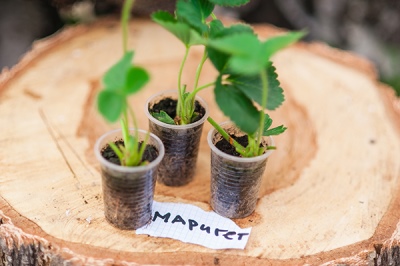
- Authors: France
- Name synonyms: Mariguette
- Taste: sweet with sourness
- The size: large
- Weight: 25-30 gr
- Yield rate: high
- Repairability: Yes
- Ripening terms: medium
- Advantages: high resistance to adverse conditions
- Appointment: fresh consumption
The strawberry variety Mariguette, which was the result of the work of French breeders, was immediately highly appreciated by amateur gardeners. This is a versatile variety that is suitable both for growing for sale on large farms and for planting in a private garden.
Description of the variety
The bush is strong, powerful, vigorous, reaches a height of 30 cm, in width it can grow up to 30-40 cm.
Ripening terms
Ripening time is average. The fruiting period is in June. The latest harvest is celebrated in October, which is typical, for example, for the Moscow region.
Yield
This is a high-yielding variety, however, in extreme heat, productivity can be reduced, and under such conditions, it is possible to reduce the size of the fruit.
Berries and their taste
The variety is characterized by large fruits, their weight is 25-30 g, the shape is cone-shaped, the berries are smooth to the touch, and their color is pink. The fruits are distinguished by a good presentation. Their keeping quality under appropriate conditions reaches 5 days, and their dense skin provides good transportability even over long distances.
The berries have a pleasant, pronounced aroma of wild strawberries. The taste is sweet with sourness. Such strawberries can be frozen, made into jam or baked goods, but it is more preferable to use them fresh. Nevertheless, the fruit remains presentable even after heat treatment and freezing.
Growing features
Gardeners who decide to start planting this variety should take into account some of the features of the process. So, it is worth knowing that at high air temperatures, the mass of berries is significantly reduced, the fruits become small and unappetizing, although this does not affect the taste in any way. In general, the variety tolerates unfavorable conditions quite well.




Site selection and soil preparation
This strawberry loves a sunny area and fertile soil. The plant will feel good on a flat area or on a surface with a slope to the southwest. A big mistake would be to plant a bush on a steep slope, as well as in a place where cold air reigns. One of the advantages of Mariguette is its unpretentiousness to adverse conditions, but still, for example, drafts should be avoided.
Do not leave strawberries in one place for more than 4 years, because of this, even a healthy strong plant becomes vulnerable to disease.
The presented variety prefers to grow in soil with a neutral acidity level, not higher than 5.8 pH. The best option is loam and sandy loam with humus content. If groundwater passes close to the selected area, then high ridges are prepared in advance for planting.

Pollination
Pollination of a plant of this variety can be done manually using a piece of cotton wool wound on a stick. Some gardeners use electrical appliances to ventilate the space, this method is especially relevant for greenhouses. It is also possible to place a hive with bees on the site - this method is in demand on an area of more than 1 hectare.

One of the important techniques in strawberry care is feeding. Regular fertilization guarantees a rich harvest. There are several different ways to feed strawberries, and each of them is designed for a specific period of plant development. During flowering, fruiting and after it, feeding should be different.

Diseases and pests
Marigette strawberries are almost immune to common diseases such as powdery mildew, spotting or root rot. Pests are also not too interested in this variety. According to breeders, even with a large-scale attack on neighboring bushes, insects do not touch Mariget.

Strawberries are often subject to many dangerous diseases that can seriously undermine their condition. Among the most common are powdery mildew, gray mold, brown spot, anthracnose, and verticillosis. Before buying a variety, you need to inquire about its disease resistance.
Reproduction
Best of all, such a plant reproduces with tendrils. When choosing planting material, give preference to the outlets closest to the mother bush. Leave three sockets on the shoot. Usually about 5 tendrils with three rosettes remain on the parent plant. That is, one bush gives about 15 healthy outlets. Read on for a few rules next.
When breeding, do not grow fruits and rosettes on the same mother bush. Peduncles should be removed immediately.
Choose planting material from bushes that have been bearing fruit for 2 years.
When planting a seedling in the first two days, cover the shoot with paper, not very tightly. For the first week, water the young sprout two or three times a day from a watering can. For 1 sq. m, use 2-3 liters of water. These actions will allow the seedling to take root well. Further, the plant needs watering once a week.
In extreme heat, the culture requires humidification every 4-5 days.
In August, loosen the soil 2 or 3 times to a depth of 3-4 cm.
In October, mulch the soil with peat or sawdust.
In November, cover the bushes with spruce branches so that the snow lingers in the garden.

Review overview
Amateur gardeners appreciate the sweet taste and bright aroma of the berries. Experienced summer residents compare Mariguette with other varieties. For example, in comparison with the San Andreas variety, the Mariget strawberry is characterized by greater winter hardiness and better rain resistance. Gardeners also like the fact that all fruits when harvested are the same size and shape. Of the minuses, weak peduncles are noted.


















































































